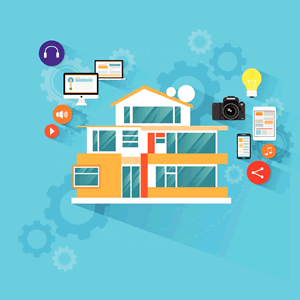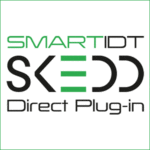Intelligent Buildings and Smart Homes: Solving for Connectivity
With technology costs decreasing, growing consumer interest in connected home applications, and greater reliance on the efficiency of the Cloud, solutions for home and commercial building automation become more sophisticated and accessible.
Intelligent Buildings and Smart Homes
 The global home automation market now encompasses all controllable elements in the modern home. Connected lighting, appliances, entertainment, and access devices are all commercially available for professional and DIY installation. Driven by safety and security concerns, energy savings potential, and convenience, the main home automation elements of lighting, safety, security, entertainment, HVAC, and energy management can now be controlled with existing technologies. This convergence of market drivers and technologies has resulted in significant market growth potential, with overall market values estimated at $3.6 billion in 2012 and growing to $16.4 billion by 2019. This growth is being led by North America, with a total market share of 40.7% of global home automation installations.
The global home automation market now encompasses all controllable elements in the modern home. Connected lighting, appliances, entertainment, and access devices are all commercially available for professional and DIY installation. Driven by safety and security concerns, energy savings potential, and convenience, the main home automation elements of lighting, safety, security, entertainment, HVAC, and energy management can now be controlled with existing technologies. This convergence of market drivers and technologies has resulted in significant market growth potential, with overall market values estimated at $3.6 billion in 2012 and growing to $16.4 billion by 2019. This growth is being led by North America, with a total market share of 40.7% of global home automation installations.
Safety and Security
Established security companies such as ADT are leveraging the connected home trend as the foundation for expanded home automation offerings through SHaaS (Smart Home as a Service). In addition, broadband providers such as AT&T and Comcast and energy companies such as British Gas have also created new revenue streams through SHaaS. Broadband, cable, and energy operators are uniquely positioned to succeed in this market, as they have millions of customers who rely on their services for energy management and data access. Since these service providers seldom design their own components, a wide range of commercially available, interoperable, and easily deployed hardware – such as relays, switches, connectors, sensors, and passives – is necessary and critical for growth of the SHaaS market.
Connected Consumers
The connected consumer is a major driver for the connected home industry, as 78% of US consumers own mobile devices, and they realize the value of controlling home functions – such as heating and cooling systems – from anywhere they happen to be. Being able to adjust a home’s temperature from the office or check whether a door is locked is a capability not possible even 10 years ago. The inherent GPS tracking capabilities in mobile devices create new application options through geo-tracking, such as the ability to unlock a door and turn on the lights as a homeowner enters his or her driveway. Other capabilities are enabled by interfaces to personal wearables, such as fitness and health monitoring devices that can signal a home automation system to dim lights when it senses the user is asleep or open blinds when the user is waking. These health-monitoring options are also creating new market spaces, such as age-in-place applications that enable real-time monitoring of the elderly and the devices in their homes – a better alternative to moving them to more costly assisted living facilities. The growth of such markets and the development of applications will require the hardware necessary for connectivity.
Wireless and Radio Protocols
Another technology driver of the connected home market is the coalescence of wireless and radio protocols. The smorgasbord of open and closed protocols and communication standards is typical in a nascent industry. ZigBee, ZWave, KNX, Thread/6LowPAN, Bluetooth LE, and Wi-Fi all are in play in this market, with some manufacturers staking their claims on one protocol, as others hedge their bets and implement two or more in their products. Each protocol has its strengths, and although they are all different, their combined penetration in the market space is valuable since each illustrates what is possible within a home automation implementation. However, it is likely that only one or two protocols will prevail. Fortunately, the hardware required for connectivity is the same regardless of which communication chip or protocol is implemented.
Connectivity is critical to the efficient manufacture, assembly, and installation of these devices, which are found in all major sub-systems in the automated home, including:
- Lighting equipment and controls
- Safety equipment and controls
- Security equipment and controls
- Entertainment
- Portable consumer electronics
- HVAC equipment and controls
- Energy management equipment and controls
- White goods
- Portable appliances
Selecting the right connector, switch, relay, or sensor for the device and its application is key to ensuring a long and trouble-free product life. For example, misapplication of products can be a major headache for OEMs, causing product failures that can take years to rectify. Component manufacturers should help their customers make these important decisions early in the product development process, where optimization of a design is most important. The major elements are in place to drive growth in the connected-home market and include:
- Established communication protocols
- Hardware that supports these protocols
- Hardware that interfaces with all main home automation systems (HVAC, security, safety, entertainment, lighting)
- Cloud-based access for mobile devices
- Cloud-based inter-protocol translation
- Improving and more reasonable price points
However, a number of roadblocks currently limit widespread adoption and are worth mentioning.
Data Security
Data security is an issue for home automation and across all Internet-of-Things-connected devices. Whenever a new system or product is released, it becomes a new target for cyber attacks. It is unlikely that an ironclad solution to attacks on connected home systems will be developed in the near future. However, today’s connected consumer is accustomed to these risks and accepts them in exchange for the benefits offered by connectivity.
Standardization
The lack of cohesiveness and standardization across a broad group of competitors may also limit the adoption of home automation technology. Consumers have expressed concerns about committing to a specific system that is not interoperable with other devices; these differences in protocol and communication limit economies of scale but are characteristic of any new technology revolution. Fortunately, hardware remains the same across protocols – so the hardware currently in development will help drive adoption of home automation, no matter which protocols become standard.
Consumer Awareness
Though many devices for home automation are on store shelves today or available for online purchase, many consumers are confused about the value proposition. For example, a consumer who is in the market for a new refrigerator will need a knowledgeable retail sales associate and comprehensive content on the Internet to explain the benefits and value of a connected home appliance. Without front-line education during the sales cycle, a consumer could opt out, and the connected home capabilities and value would go unrealized. The connected home market is still in the early-adopter phase, and many startup companies are jockeying for position and for consumer attention.
Commercial Buildings
The commercial building automation space is different from home automation in many aspects. Its growth is tied heavily to commercial building construction trends, which in this decade have been relatively slow and tempered by the reduction in the commercial building construction pace in China. The resulting building automation space therefore sees compound annual growth rates (CAGRs) in some regions in the area of 8.5%, and in other regions less than 5% with global growth averaging around 5.5%. The growth expectations for this particular market are far less than what is projected for home automation. Building automation for commercial buildings started with early pneumatic controls and has developed into a mature market. Developers of these systems have moved beyond the formerly heavily segregated, separate systems controlling HVAC, security/access, lighting control, building safety, and physical plant control. Today, through integrated system controllers, these separate systems can now talk to one another using a common language made possible by modern serial bus communications such as BACNET and KNX.
Progress in the Commercial Market
Cloud capabilities have brought this market a level of management and control not seen in the past and have made possible complex heuristics that make the modern building much more intelligent than its predecessors. In today’s commercial building systems, many of the bugs and issues now manifesting themselves in home automation have long since been ironed out through the standardization present in BACNET and KNX protocols. The Cloud simplifies multi-building management and serves as a data aggregator for building managers responsible for multiple buildings without the need for a large IT staff to manage a dedicated system.
While both these systems initially emerged as hard-wired, they have been extended into wireless realms to provide connectivity in less accessible conditions. A vast majority of the commercial building systems remain wired, though, due to the simplicity of installing, maintaining, and troubleshooting such systems. Another factor in the steady reliability of commercial systems is that they are all professionally installed and designed in close communication among the building architect, general contractor, electrical contractor, and low voltage controls contractor. In some instances, even the building owner is involved in the decision process, since a building owner with multiple plants under its control almost always selects the same system. In this way, facility maintenance personnel have a common system to maintain, control, and troubleshoot if needed, creating a strong brand alliance in the commercial controls space.
High Demand for Sensors
The need for sensors is even more important in the commercial building space. Building managers need to know what is going on in their buildings, including who is accessing the buildings and at what time, how much energy is being used, where the energy is used, what areas of the buildings are occupied, how uniform environmental conditions are, and how efficiently the physical plant is being run (e.g., is a bearing going bad or a filter plugged?). In addition to the sensors, there are far more actuators in a commercial building. A centralized control system may take readings from multiple airflow sensors in a building and dynamically adjust airflow dampers to ensure equalized airflow and comfort throughout the building. From a safety standpoint, if a smoke or flame detector indicates a fire in one part of a building, the system may completely close the air dampers on the area where the fire is detected to starve the fire of oxygen, while at the same time activating the building fire suppression system through remote actuated valves.
To read this white paper in its entirety, click here.
This white paper excerpt was contributed by TE Connectivity.



